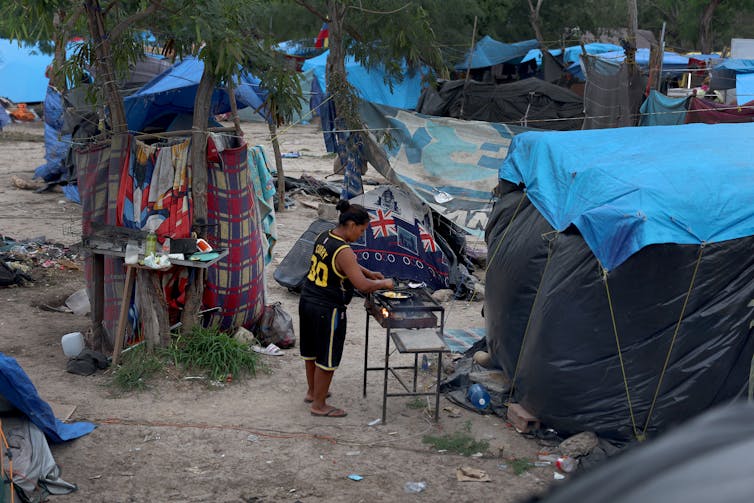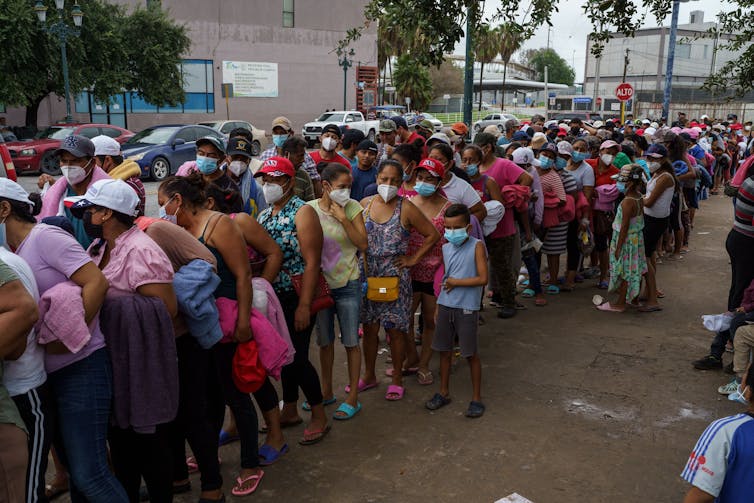As debate over U.S. immigration policy heats up during the 2024 presidential campaign, separating fact from fiction on the U.S.-Mexico border becomes increasingly difficult.
In May 2023, shortly after the end of a public health restriction that allowed U.S. officials to immediately expel asylum-seekers, a team of academic and humanitarian aide colleagues and I went to the Mexican city of Matamoros, just across the Rio Grande from the banks of Brownsville, Texas.
At the time, we didn’t encounter the “invasion at the border” that conservative lawmakers such as Texas Gov. Greg Abbott predicted would happen once the COVID-19 restrictions – officially known as Title 42 – expired.
From what we learned, the actual rush of thousands of people across the border occurred in the days before Title 42 was lifted on May 11, 2023. Many migrants told us they saw it as their last chance to cross the U.S. border.
Most people we talked to were waiting in overcrowded, temporary camps in Mexico. They feared that if they tried to cross into the U.S., they would lose their opportunity to seek asylum and would be deported under restrictive polices unveiled during the Biden administration.
The situation at the border has constantly changed ever since. In June 2024, for instance, President Joe Biden signed an executive order limiting the number of asylum seekers at the border to no more than a weekly average of 2,500 migrants. The new restrictions would be lifted once that weekly average dropped to 1,500.
The crackdown came shortly after the election of Mexico’s first female president Claudia Sheinbaum whose policies on immigration remain largely unknown.
But the brief period when Title 42 ended is a perfect illustration of the differences between right-wing hysteria and the realities on the ground.
The evolution of US border policy
Since the fall of 2019, I have been working at the Mexican border cities of Reynosa and Matamoros – across from McAllen and Brownsville, Texas. That year, the Trump administration had started the Migrant Protection Protocols.
Known as “Remain in Mexico,” the restrictive policy ended the possibility of asylum for about 70,000 migrants, mostly from Central America. Instead, they were forced to wait in Mexico with little realistic chance of being able to legally enter and stay in the U.S. Anyone who entered the country illegally was deported immediately and barred from applying for asylum for five years.
The border became even more restrictive during the COVID-19 pandemic when Title 42 was implemented in March 2020. It limited entry into the U.S. at the border to U.S citizens and residents.
Traditional ports of entry at the U.S.-Mexico border were closed to asylum-seekers in order to prevent the spread of COVID. For example, those who came to the ports of entry at the international bridges in Reynosa or Matamoros would be turned back at the halfway point and not allowed to touch U.S. soil.
As a result, most of the people whom we talked to in 2023 were waiting in Mexico and fearful.
Inside the asylum camps
Throughout 2020 and 2021, my academic and nonprofit colleagues witnessed migrants toiling in squalid, makeshift camps.
One of the first asylum camps was formed during the last days of the Trump administration across from Brownsville, Texas, in Matamoros, Mexico. The Mexican government allowed faith-based organizations and nongovernment organizations such as Team Brownsville and Solidarity Engineering to bring in tents, food, water and other supplies.
Before long, thousands of individuals – primarily from Central America – were sleeping on the streets next to the international bridge that connected the town to Brownsville.
At one point, the camp had about 3,000 people living in it. There were only two portable toilets.

A second, unofficial camp started around the same time in the city square of Reynosa, a town located across the border from Hidalgo, Texas. It also became overrun with people, making it difficult to even walk through the camp. Mothers told us stories of being unable to sleep at night because of the constant fear of sexual assault and violence.
Unlike many refugee camps around the world, these camps often have very little structure, almost no security and little organization. Though there are some portable toilets and, at times, makeshift showers, sanitation is a serious issue. Many people bathe in the nearby Rio Grande.
Food is scarce. Every so often, churches and nonprofit relief groups provide some aid. But it is never enough to meet the demand.

The most serious issue for those staying at the camps is protection from organized crime and drug cartels. Families with young girls were especially concerned, as sexual assaults were reported in the camps.
Women were afraid to venture out at night. Out of desperation, some even sent their children across the U.S. border alone in the hope they would be allowed to stay in the U.S.
As dangerous as that journey was, they believed it was more dangerous for the children to remain in the cartel-filled camps.
Critical choices
Thus far in the 2024 U.S. presidential election, immigration has emerged as one of the top issues among voters.
In this polarized political environment, it would be easy for those across the political spectrum to conclude that the border is chaotic and needs to be closed.
In my view, closing the border permanently – as former President Donald Trump and other right-wing lawmakers have sought to do – would be a mistake and not in the best interests of national security, the U.S. economy and, ultimately, the lives of asylum-seekers.
As a researcher who has spent countless hours with asylum-seekers and other migrants, I believe that restrictive policies – from either Trump or Biden – are helpful only to organized crime, which is often controlling immigration on the ground along the U.S.-Mexico border.
This often puts asylum-seekers in great danger, both from direct violence from the cartels and from the harsh terrain they must traverse to avoid detection by immigration officials.
If Trump returns to the White House or U.S. President Joe Biden chooses to take a harsher stance, more restrictive border policies could force people who have already fled their homelands to either stay in cartel-controlled camps or risk dying trying to enter the U.S. illegally.

